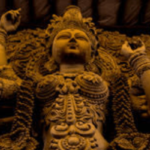Atha Yogānuśānanam.
- Atha – now
- yoga – yoga
- anuśāsanam – teaching, exposition
Now the teachings of Yoga.
Yoga comes from the ancient spiritual tradition of India. It is a process devised by the ancient seers to help us discover the divine Truth within our own beings. It is also called the path of union with God. The fundamental principles of yoga are at the heart of many spiritual paths and religions. We don’t have to be on an Indian path to experience their benefits, depth and wisdom. The Sutras form the basis of Rāja Yoga, the traditional “royal” eight-fold path of yoga, which includes the following limbs:
- Yamas, self-restraints: non-violence, truthfulness, non-stealing, control of one’s sexuality, and non-grasping.
- Niyamas, observances: purity, contentment, austerity, recitation and study of scriptural texts, and surrender to God.
- Āsanas, yogic postures.
- Prāṇāyāma, working with the breath.
- Pratyāhāra, withdrawal of the senses.
- Dhāraṇā, concentration.
- Dhyāna, meditation.
- Samādhi, the merging of the mind with the Absolute.
The Yoga Sutras go into great detail about each of these limbs. Although they are listed sequentially, we really practice them in no particular order, but together in a complementary way. The teachings offer an intricate web of practices and understandings that link the physical, mental, emotional, and spiritual aspects of our beings. They also encompass three other traditional paths of yoga: Bhakti Yoga, the heartfelt path of devotion; Jñāna Yoga, the path of understanding; and Karma Yoga, the path of service.
The Indian sage Śaṅkarāchārya wrote in the Viveka Cūḍāmaṇi: Crest Jewel of Discrimination:
It is difficult for any living creature to achieve birth in a human body. It is even harder to obtain a strong body and mind, shaped by pure thoughts and actions. More difficult is to have a desire to live a spiritual life. The most difficult of all is to have an understanding of the Truth of our own nature.
Three things are rare and come from God’s grace: human birth, the longing for liberation, and the guidance of an illumined teacher.
The sages of many traditions tell us we are in a vast process of evolution. Some say that many of us started out on this earth in mineral form and slowly evolved into plants and animals. Only after considerable lives were we granted the privilege of a human body. As a human being, we find ourselves in a world of dualities—good and bad, rich and poor, fortunate and unfortunate—in which we’re presented with lessons that allow us to learn how to make choices out of love rather than self-interest. Ultimately, we will all attain self-realization, but the process takes us many lifetimes. Once a soul has experienced sufficient lives to realize there is something deeper to life than seeking what is pleasurable, a longing for true knowledge of the human condition arises. As Śaṅkarāchārya says, this longing is rare, not because some souls are better than others, but because it takes so long to reach this point of evolution. This longing for self-knowledge, in turn, draws a seeker to an illumined teacher, one who has experienced the Truth as it is, and is able to teach it in a way that allows us to progress steadily on our spiritual paths.
The yoga scriptures of India speak of a divine force within us called kuṇḍalinī śakti that persistently draws us toward the light within so that we can recognize the divinity at the core of our beings. In all objects, animate or inanimate, this divine energy pulsates, propelling us, in whatever form we are in, to wake up to our divine essence. The first step on a spiritual path comes when we get in touch with this inner longing, a deep desire to experience something more to life, to transcend what seems to be our inherent limitations, our identifications with what is superficial and material. The Indian scriptures call this inner yearning mumukṣutva.
There is a mysterious strength in the divine, inner desire that lights our way to the Truth. The Sufi poet Rumi gave beautiful expression to this inner yearning:
By the rising moon in my dark nights
I am thirsty for Your light….
My heart cannot bear the pain of separation….
When we contact this longing for Love, for completeness, for union with the Divine, our inner journey begins.
Exercise
Let’s contemplate the inner force within that propels us toward our own light. Sit in a meditative posture and for a few minutes watch your breath rise and fall, rise and fall, in a natural manner, allowing your mind to become quiet. Then ask yourself, “What is my deepest inner desire?” As ideas come out, write them down, whether you think you agree with them or not. After writing all that comes to you, be quiet again and go back to watching your breath for a few minutes. Once your mind is quiet and you feel peaceful inside, review what you have written and contemplate where your desires have come from, which ones are truly what you want, and whether some of your desires contradict others. Then write again what you have discovered.








